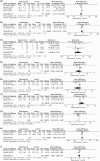Outcomes of dermal substitutes in burns and burn scar reconstruction: A systematic review and meta-analysis
- PMID: 39435560
- PMCID: PMC11584356
- DOI: 10.1111/wrr.13226
Outcomes of dermal substitutes in burns and burn scar reconstruction: A systematic review and meta-analysis
Abstract
Dermal substitutes have been introduced in burn care to improve wound healing outcomes; however, their use remains limited in standard treatments. This systematic review and meta-analysis aimed to evaluate the outcomes of dermal substitutes in patients with burns and patients requiring burn scar reconstruction and subsequently contribute to optimising the integration of dermal substitutes into clinical practice and reducing the knowledge gap. A comprehensive search across various databases included human studies from peer-reviewed journals on dermal substitutes for deep dermal and full-thickness burns, and scar reconstruction across all ages. Data from comparative trials were extracted, focusing on patient and wound characteristics, treatment specifics, and outcomes related to wound healing and scar quality. Meta-analysis was performed on trials reporting similar post-burn measures, with statistical heterogeneity assessed. Outcomes were presented using mean differences or odds ratios with 95% confidence intervals. A total of 31 comparative trials were included. The overall quality of the studies was considered moderate. The meta-analysis indicated delayed re-epithelialization 4-7 days after treatment with a collagen-elastin matrix compared to split-thickness skin graft in acute burns (-7.30%, p = 0.02). Significant improvement in subjective scar quality was observed with acellular dermal matrix compared to split-thickness skin graft in acute burn wounds 6 months post-operative (-1.95, p <0.01). While acknowledging the initially delayed wound healing, incorporating dermal substitutes into the surgical treatment of burn patients holds promise for enhancing scar quality. However, future research must prioritise outcome measure uniformity, address variations in dermal substitute application, and standardise indications for consistent and effective practices.
Keywords: burn reconstruction; burns; dermal substitutes; meta‐analysis; surgery; systematic review; tissue engineering.
© 2024 The Author(s). Wound Repair and Regeneration published by Wiley Periodicals LLC on behalf of The Wound Healing Society.
Conflict of interest statement
There is no conflict of interest in this research.
Figures


 Low risk;
Low risk;  Some risk;
Some risk;  High risk. (B) Assessment of risk of bias using the Cochrane Collaboration's risk of bias tool 2—reconstruction of burn scars.
High risk. (B) Assessment of risk of bias using the Cochrane Collaboration's risk of bias tool 2—reconstruction of burn scars.  Low risk;
Low risk;  Some risk;
Some risk;  High risk.
High risk.

References
Publication types
MeSH terms
Grants and funding
LinkOut - more resources
Full Text Sources
Medical
Miscellaneous

